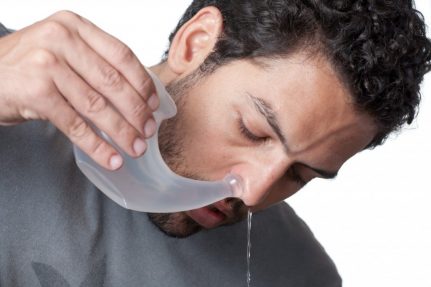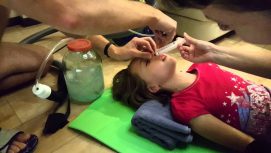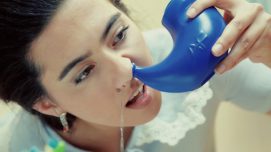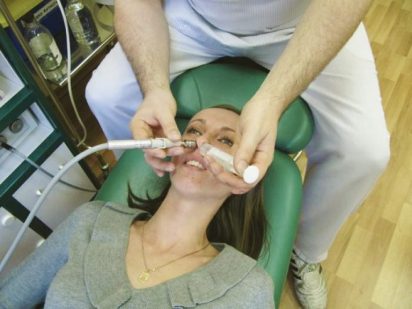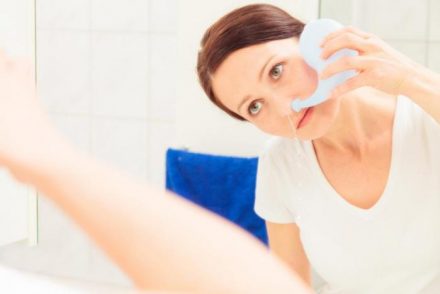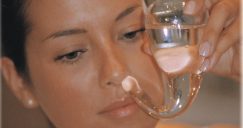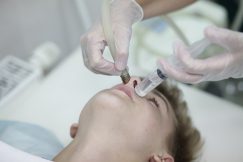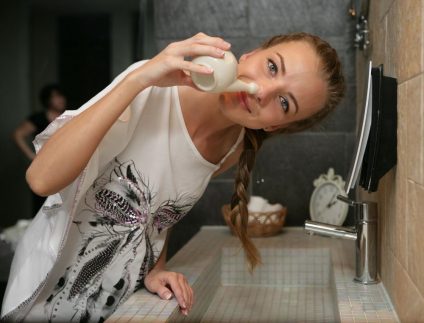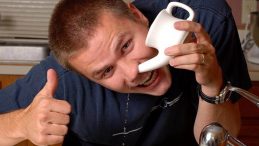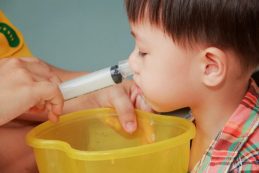Probably everyone heard about the cuckoo nose washing procedure. It was developed specifically for the effective treatment of sinusitis and sinusitis and is a complex of hygienic and therapeutic methods of irrigation and purification of the nasal cavity.
Material Content:
What is the cuckoo procedure?
The method is a gradual and accurate infusion of an antiseptic solution through one nostril and simultaneous suction of the same liquid through another along with the accumulated purulent contents. Most often, a special vacuum apparatus is used for this. Sometimes the procedure is carried out using 20-milliliter syringes for injecting the solution into the nasal cavity and plastic pears for suction in turn from each hole. Rinsing each nostril requires approximately 110 ml.
When washing from the surface of the mucosa, along with the medicinal fluid, pathological secretions, mucus, microbes, pus, dried crusts, allergens, and dirt are removed.
This helps to increase the tone of capillaries, reduce inflammation and swelling, improve the functioning of the cells of the mucous membrane, enhance the movement of mucus, and facilitate the patient’s breathing. A positive result is often noticeable after the first procedure, however, to consolidate the effect and complete recovery, it is necessary to completely complete the course prescribed by the doctor.
Medical name of the method
Among the inhabitants, the method has the interesting name “cuckoo”, since during the entire manipulation the patient must constantly pronounce the syllables “cuckoo” so that the liquid can go out under pressure.But in medicine, this method of treatment has a more "solid" name - the method of moving fluid along the Proetz. It was developed by an otolaryngologist in America more than a century ago and is still popular today.
For washing, different solutions are used:
- antibiotic
- antiseptic;
- vasoconstrictor.
Some people try to carry out such manipulation at home. However, without knowledge of physiology and certain skills, this is difficult to accomplish. Self-washing, unfortunately, very often leads to the development of various complications.
Indications for washing the sinuses according to Proetz
Washing of the sinuses is carried out in such cases:
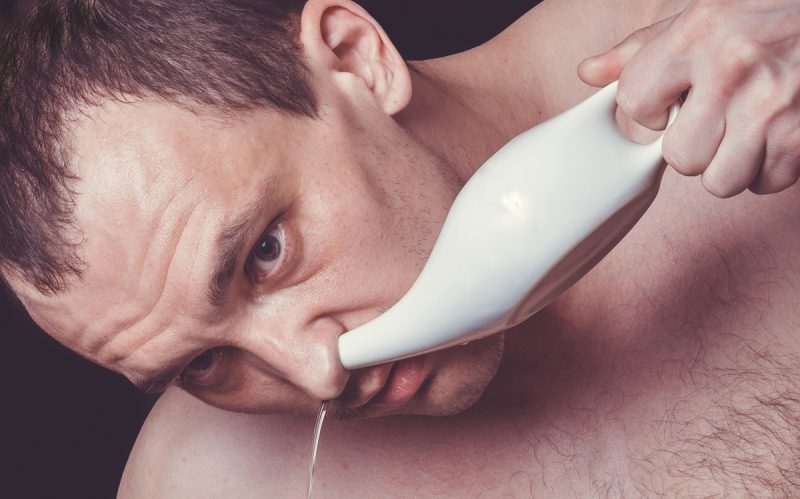
- runny nose;
- tonsillitis;
- polyps;
- adenoiditis;
- sinusitis;
- the presence of infection.
This method has helped many people to avoid unpleasant and painful manipulations with sinusitis - a puncture. With a mild runny nose, relief comes almost instantly, so the disease does not go into more serious forms.
This procedure is recommended for such categories of patients:
- children from 5-6 years old (sometimes this sometimes can not be done due to the anatomical features of the structure of the organ or the lack of understanding of the process by the kids);
- adults with nasal diseases;
- pregnant.
The duration of treatment varies from 5 to 9 sessions, depending on the severity of the disease.
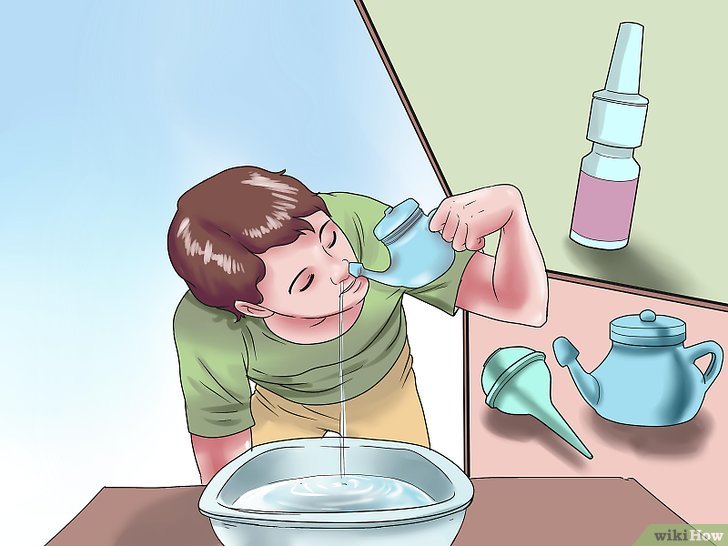 The Cuckoo procedure is often not liked by children, as it scares them. In such cases, the doctor must find an approach to the small patient and help him get rid of his fear. If the child still does not agree to the manipulation, you need to choose other methods of treatment.
The Cuckoo procedure is often not liked by children, as it scares them. In such cases, the doctor must find an approach to the small patient and help him get rid of his fear. If the child still does not agree to the manipulation, you need to choose other methods of treatment.
Preparation for the procedure
Special preparations before undergoing the ENT procedure are not required. It is only necessary to instill vasoconstrictor drugs in each nostril in order to remove all obstacles in the form of puffiness. If this is not done, pathological microflora can fall into the middle ear. In addition, vasoconstrictor drops dilate the nasal passages and make manipulation more effective.
It is better not to drip the drug, but to make thin and narrow turundochki (flagella) from cotton wool or gauze, moisten in the medicine and put in the nostrils for 7-8 minutes.

Process description
The patient should behave correctly while washing the nose according to Proetz:
- breathe while maintaining a normal rhythm;
- Do not move unnecessarily;
- lie flat on your back, throwing your head back 45 degrees and not tossing it (children, as a rule, are laid on their side);
- do not panic.
The doctor prepares the necessary tools and instruments, and then begins rinsing. At the direction of the healthcare provider, the patient should begin to say “cuckoo” and not stop before the doctor’s signal. When pronouncing this syllable, the upper palate blocks the nasopharynx, which creates the necessary pressure difference, and the fluid does not enter the oral cavity and larynx. You need to cook clearly, without rushing and without swallowing the syllables. The passage of fluid through the sinuses directly depends on this.
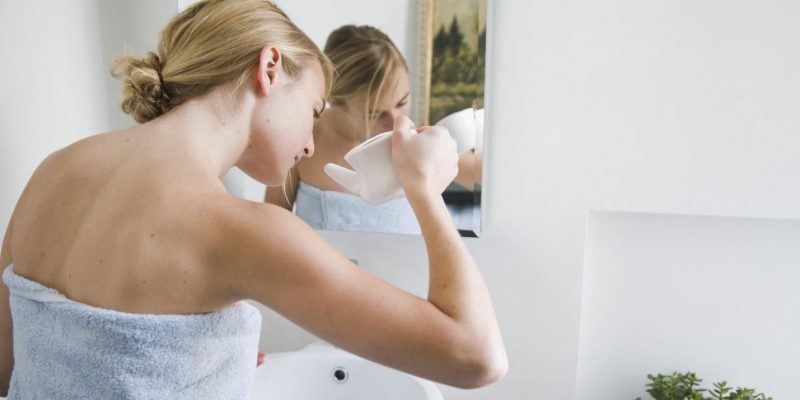 The medical worker must create a smooth flow of fluid from one nasal passage to another, and the patient can help him in this by strictly following the required recommendations. If the procedure causes severe pain or discomfort, you should give a sign to the doctor. After that, it should facilitate vacuum suction.
The medical worker must create a smooth flow of fluid from one nasal passage to another, and the patient can help him in this by strictly following the required recommendations. If the procedure causes severe pain or discomfort, you should give a sign to the doctor. After that, it should facilitate vacuum suction.
The total duration of the manipulation does not take more than 9 minutes.
The drug may not have a very pleasant aftertaste and may cause irritation. The sounds made by the Kukushka apparatus and the situation of the manipulation cabinet can cause tension, fear and emotional discomfort. However, there is nothing wrong with this manipulation. Sometimes there is a feeling that you can choke. But this certainly won’t happen if you continuously cook, and breathe through your mouth during short breaks. Even the most fearful patients then point out that such a rinse is a completely bearable procedure.
In rare cases, the manipulation is complicated, and the ENT firmly clamps the nostril for a few moments, and then abruptly releases it.This is done in order to improve the flow of fluid into the sinuses. While using this method, the patient may feel unpleasant pressing pain between the eyebrows.
Using the method during pregnancy
Bearing a fetus is not a contraindication to manipulation. The method is good because the drugs are delivered directly to the sore spot, act locally and do not affect other organs. Therefore, there is no danger to pregnant women.
The main thing is that the doctor selects a safe drug and solution. Properly performed washing will alleviate the condition and help to avoid taking strong antibiotics and surgical intervention.
Possible complications
To avoid complications, the patient is not recommended to immediately go out. In the cold season, you need to wait at least an hour, and preferably two, and only then go out into the frosty air. In spring and summer, 25-30 minutes are enough. This limitation is due to the fact that after washing in the sinuses of the nose, a small amount of liquid still remains. Going out into the street immediately after the manipulation, the patient increases the risk of local sinus hypothermia due to inhalation of cold air and the presence of water inside.
Of the negative consequences of manipulation, it is necessary to highlight:
- bleeding due to injuries of the nasal mucosa due to a sloppy procedure;
- burning sensation (usually disappears within an hour);
- redness of the eye proteins;
- dizziness;
- headache (quite tolerable);
- vomiting or nausea (most often in children).
And also sometimes patients can sneeze, complain of stuffy ears. But in most cases, patients, on the contrary, feel the desired feeling of freedom, lightness and moisture inside. The nose may not breathe right away, but the mucus will begin to discharge better, and overall well-being will improve significantly.
In rare cases, complications arise. This happens due to a violation of the technique or the presence of an obstacle inside. Because of this, an existing pathology can transform into a more serious stage. Infection can further provoke the development of otitis media.
Contraindications
Of the contraindications, only epilepsy, mental illness and the presence of nosebleeds should be mentioned. And also in some cases, the manipulation cannot be carried out due to anatomical violations of the structure of the organ (for example, curvature of the nasal septum), but this is very rare.
Children's preschool age is a relative contraindication. The kids do not understand what needs to be cooked, but instead begin to cry or scream. If the child is conscious and obedient, ready to follow the doctor’s commands, then you can try this method.
Rinsing the nose is a very effective procedure, however, it must be carried out in conjunction with other activities, taking the medications prescribed by the doctor and following his recommendations.


